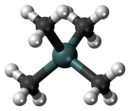Tetramethyltin
| |||
| Names | |||
|---|---|---|---|
| Preferred IUPAC name
Tetramethylstannane[1] | |||
| Other names
Tin tetramethyl
| |||
| Identifiers | |||
3D model (
JSmol ) |
|||
| 3647887 | |||
| ChEBI | |||
| ChemSpider | |||
ECHA InfoCard
|
100.008.941 | ||
| EC Number |
| ||
| 1938 | |||
PubChem CID
|
|||
RTECS number
|
| ||
| UNII | |||
| UN number | 3384 | ||
CompTox Dashboard (EPA)
|
|||
| |||
SMILES
| |||
| Properties | |||
| C4H12Sn | |||
| Molar mass | 178.850 g·mol−1 | ||
| Appearance | Colorless liquid | ||
| Density | 1.291 g cm−3 | ||
| Melting point | −54 °C (−65 °F; 219 K) | ||
| Boiling point | 74 to 76 °C (165 to 169 °F; 347 to 349 K) | ||
| Hazards | |||
| GHS labelling: | |||
  
| |||
| Danger | |||
| H225, H300, H310, H330, H410 | |||
| P210, P233, P240, P241, P242, P243, P260, P262, P264, P270, P271, P273, P280, P284, P301+P310, P302+P350, P303+P361+P353, P304+P340, P310, P320, P321, P322, P330, P361, P363, P370+P378, P391, P403+P233, P403+P235, P405, P501 | |||
| NFPA 704 (fire diamond) | |||
| Flash point | −12 °C (10 °F; 261 K) | ||
| Related compounds | |||
Related tetraalkylstannanes
|
|||
Related compounds
|
| ||
Except where otherwise noted, data are given for materials in their standard state (at 25 °C [77 °F], 100 kPa).
| |||
Tetramethyltin is an
Synthesis and structure
Tetramethyltin is synthesized by reaction of the Grignard reagent
- 4 CH3MgI + SnCl4 → (CH3)4Sn + 4 MgICl
In tetramethyltin, the metal surrounded by four
Applications
Precursor to methyltin compounds
Tetramethyltin is a precursor to trimethyltin chloride (and related methyltin halides), which are precursors to other organotin compounds. These methyltin chlorides are prepared via the so-called Kocheshkov redistribution reaction. Thus, (CH3)4Sn and SnCl4 are allowed to react at temperatures between 100 °C and 200 °C to give (CH3)3SnCl as a product:
- SnCl4 + 3 (CH3)4Sn → 4 (CH3)3SnCl
A second route to trimethyltin chloride utilizing tetramethyltin involves the reaction of mercury(II) chloride to react with (CH3)4Sn.[2]
- 4 HgCl2 + 4 (CH3)4Sn → 4 Me3SnCl + 4 MeHgCl
A variety of methyltin compounds are used as precursors for stabilizers in
Surface functionalization
Tetramethyltin decomposes in the gas phase at about 277 °C; (CH3)4Sn vapor reacts with
- (CH3)4Sn + ≡SiOH → ≡SiOSn(CH3)3 + MeH
This reaction is also possible with other alkyl substituents. In a similar process, tetramethyltin has been used to functionalize certain zeolites at temperatures as low as −90 °C.[4]
Applications in organic synthesis
In
- SnMe4 + RCOCl → RCOMe + Me3SnCl
References
- ^ "Tetramethyltin | C4H12Sn". ChemSpider. Retrieved 2013-09-15.
- ^ ISBN 0471936235.
- ^ hdl:1874/6594.
- ISBN 9780080450476.
- .



